Detailed Report: Australia's National Mental Health Policy
VerifiedAdded on 2022/09/23
|5
|1366
|23
Report
AI Summary
This report provides a literature review of Australia's National Mental Health Policy, adopted in April 1992, emphasizing its role in protecting consumer rights and setting national service standards. The policy, a collaborative effort between the Commonwealth, State, and Territory governments, focuses on human rights, quality of service, and patient decision-making. It addresses the needs of consumers and carers, elaborating minimum standards for treatment and promoting collaboration among practitioners to improve service quality. The policy also highlights the importance of social inclusion, recovery-based interventions, and integrated services, particularly for those with chronic mental illnesses. The report references various perspectives to analyze the policy's effectiveness, revisions, and its impact on mental health care delivery and consumer support. It also explores the role of care providers in the assessment, diagnosis, and treatment of patients and discusses the reforms introduced to enhance the efficiency of services.
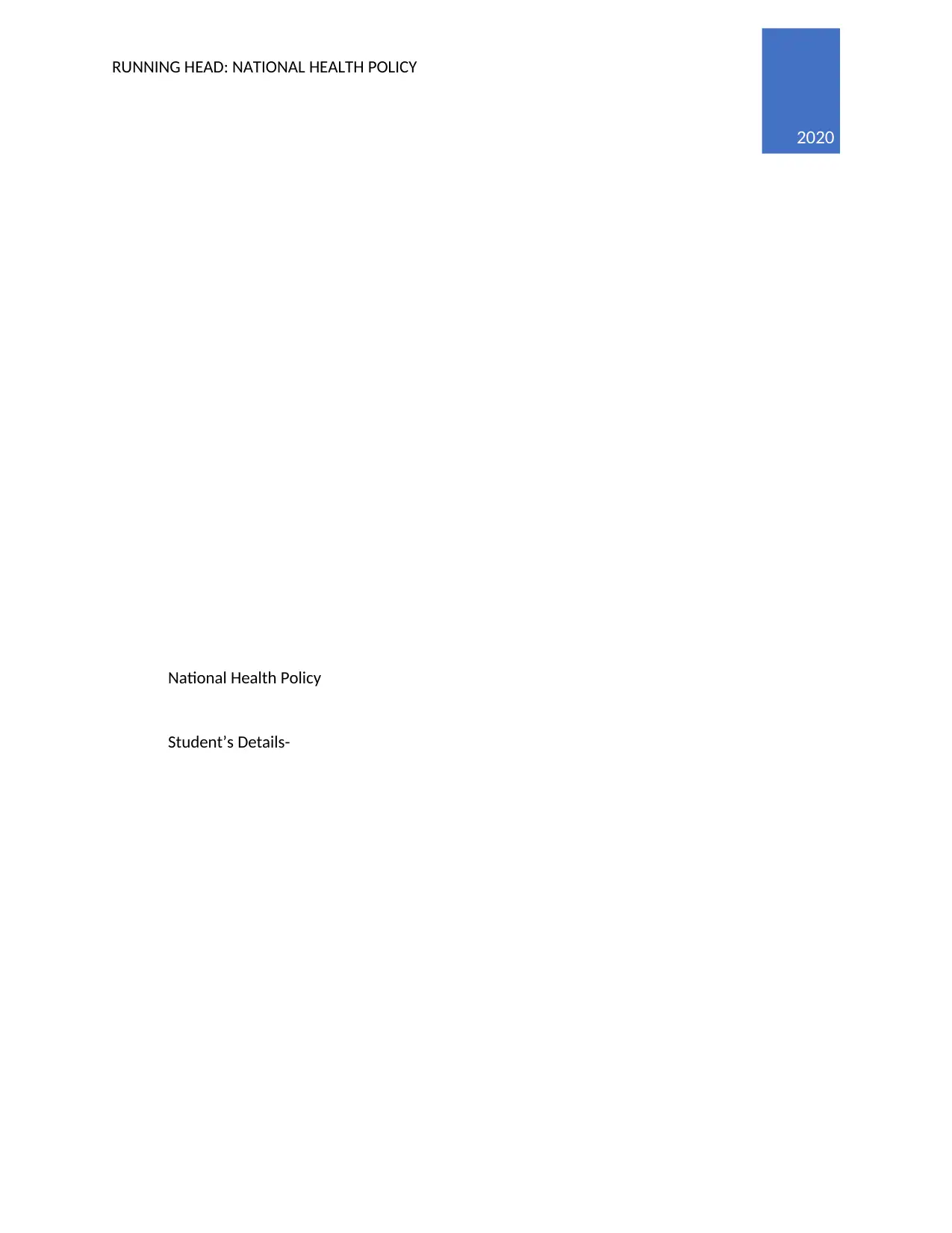
RUNNING HEAD: NATIONAL HEALTH POLICY 0
2020
National Health Policy
Student’s Details-
2020
National Health Policy
Student’s Details-
Paraphrase This Document
Need a fresh take? Get an instant paraphrase of this document with our AI Paraphraser
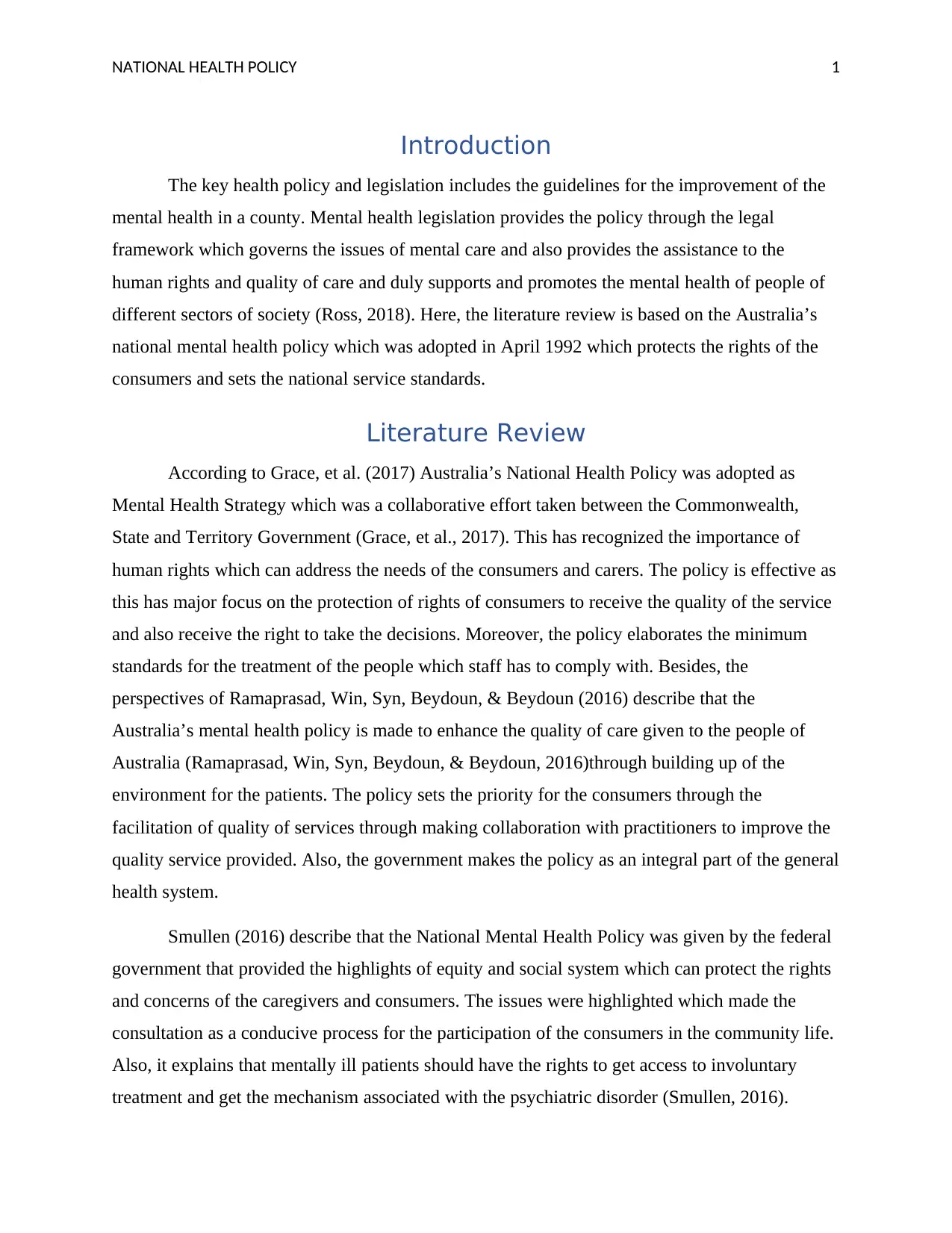
NATIONAL HEALTH POLICY 1
Introduction
The key health policy and legislation includes the guidelines for the improvement of the
mental health in a county. Mental health legislation provides the policy through the legal
framework which governs the issues of mental care and also provides the assistance to the
human rights and quality of care and duly supports and promotes the mental health of people of
different sectors of society (Ross, 2018). Here, the literature review is based on the Australia’s
national mental health policy which was adopted in April 1992 which protects the rights of the
consumers and sets the national service standards.
Literature Review
According to Grace, et al. (2017) Australia’s National Health Policy was adopted as
Mental Health Strategy which was a collaborative effort taken between the Commonwealth,
State and Territory Government (Grace, et al., 2017). This has recognized the importance of
human rights which can address the needs of the consumers and carers. The policy is effective as
this has major focus on the protection of rights of consumers to receive the quality of the service
and also receive the right to take the decisions. Moreover, the policy elaborates the minimum
standards for the treatment of the people which staff has to comply with. Besides, the
perspectives of Ramaprasad, Win, Syn, Beydoun, & Beydoun (2016) describe that the
Australia’s mental health policy is made to enhance the quality of care given to the people of
Australia (Ramaprasad, Win, Syn, Beydoun, & Beydoun, 2016)through building up of the
environment for the patients. The policy sets the priority for the consumers through the
facilitation of quality of services through making collaboration with practitioners to improve the
quality service provided. Also, the government makes the policy as an integral part of the general
health system.
Smullen (2016) describe that the National Mental Health Policy was given by the federal
government that provided the highlights of equity and social system which can protect the rights
and concerns of the caregivers and consumers. The issues were highlighted which made the
consultation as a conducive process for the participation of the consumers in the community life.
Also, it explains that mentally ill patients should have the rights to get access to involuntary
treatment and get the mechanism associated with the psychiatric disorder (Smullen, 2016).
Introduction
The key health policy and legislation includes the guidelines for the improvement of the
mental health in a county. Mental health legislation provides the policy through the legal
framework which governs the issues of mental care and also provides the assistance to the
human rights and quality of care and duly supports and promotes the mental health of people of
different sectors of society (Ross, 2018). Here, the literature review is based on the Australia’s
national mental health policy which was adopted in April 1992 which protects the rights of the
consumers and sets the national service standards.
Literature Review
According to Grace, et al. (2017) Australia’s National Health Policy was adopted as
Mental Health Strategy which was a collaborative effort taken between the Commonwealth,
State and Territory Government (Grace, et al., 2017). This has recognized the importance of
human rights which can address the needs of the consumers and carers. The policy is effective as
this has major focus on the protection of rights of consumers to receive the quality of the service
and also receive the right to take the decisions. Moreover, the policy elaborates the minimum
standards for the treatment of the people which staff has to comply with. Besides, the
perspectives of Ramaprasad, Win, Syn, Beydoun, & Beydoun (2016) describe that the
Australia’s mental health policy is made to enhance the quality of care given to the people of
Australia (Ramaprasad, Win, Syn, Beydoun, & Beydoun, 2016)through building up of the
environment for the patients. The policy sets the priority for the consumers through the
facilitation of quality of services through making collaboration with practitioners to improve the
quality service provided. Also, the government makes the policy as an integral part of the general
health system.
Smullen (2016) describe that the National Mental Health Policy was given by the federal
government that provided the highlights of equity and social system which can protect the rights
and concerns of the caregivers and consumers. The issues were highlighted which made the
consultation as a conducive process for the participation of the consumers in the community life.
Also, it explains that mentally ill patients should have the rights to get access to involuntary
treatment and get the mechanism associated with the psychiatric disorder (Smullen, 2016).
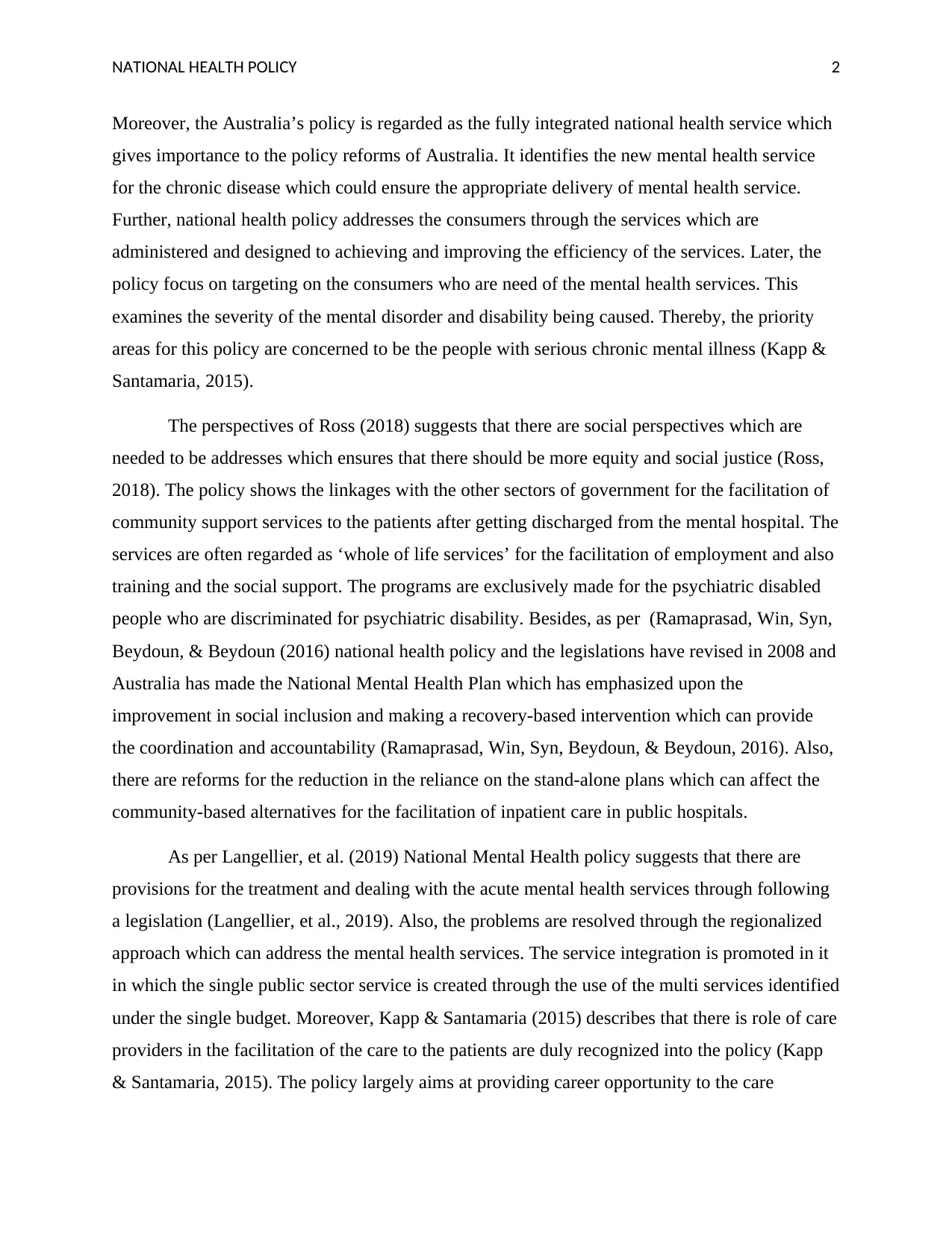
NATIONAL HEALTH POLICY 2
Moreover, the Australia’s policy is regarded as the fully integrated national health service which
gives importance to the policy reforms of Australia. It identifies the new mental health service
for the chronic disease which could ensure the appropriate delivery of mental health service.
Further, national health policy addresses the consumers through the services which are
administered and designed to achieving and improving the efficiency of the services. Later, the
policy focus on targeting on the consumers who are need of the mental health services. This
examines the severity of the mental disorder and disability being caused. Thereby, the priority
areas for this policy are concerned to be the people with serious chronic mental illness (Kapp &
Santamaria, 2015).
The perspectives of Ross (2018) suggests that there are social perspectives which are
needed to be addresses which ensures that there should be more equity and social justice (Ross,
2018). The policy shows the linkages with the other sectors of government for the facilitation of
community support services to the patients after getting discharged from the mental hospital. The
services are often regarded as ‘whole of life services’ for the facilitation of employment and also
training and the social support. The programs are exclusively made for the psychiatric disabled
people who are discriminated for psychiatric disability. Besides, as per (Ramaprasad, Win, Syn,
Beydoun, & Beydoun (2016) national health policy and the legislations have revised in 2008 and
Australia has made the National Mental Health Plan which has emphasized upon the
improvement in social inclusion and making a recovery-based intervention which can provide
the coordination and accountability (Ramaprasad, Win, Syn, Beydoun, & Beydoun, 2016). Also,
there are reforms for the reduction in the reliance on the stand-alone plans which can affect the
community-based alternatives for the facilitation of inpatient care in public hospitals.
As per Langellier, et al. (2019) National Mental Health policy suggests that there are
provisions for the treatment and dealing with the acute mental health services through following
a legislation (Langellier, et al., 2019). Also, the problems are resolved through the regionalized
approach which can address the mental health services. The service integration is promoted in it
in which the single public sector service is created through the use of the multi services identified
under the single budget. Moreover, Kapp & Santamaria (2015) describes that there is role of care
providers in the facilitation of the care to the patients are duly recognized into the policy (Kapp
& Santamaria, 2015). The policy largely aims at providing career opportunity to the care
Moreover, the Australia’s policy is regarded as the fully integrated national health service which
gives importance to the policy reforms of Australia. It identifies the new mental health service
for the chronic disease which could ensure the appropriate delivery of mental health service.
Further, national health policy addresses the consumers through the services which are
administered and designed to achieving and improving the efficiency of the services. Later, the
policy focus on targeting on the consumers who are need of the mental health services. This
examines the severity of the mental disorder and disability being caused. Thereby, the priority
areas for this policy are concerned to be the people with serious chronic mental illness (Kapp &
Santamaria, 2015).
The perspectives of Ross (2018) suggests that there are social perspectives which are
needed to be addresses which ensures that there should be more equity and social justice (Ross,
2018). The policy shows the linkages with the other sectors of government for the facilitation of
community support services to the patients after getting discharged from the mental hospital. The
services are often regarded as ‘whole of life services’ for the facilitation of employment and also
training and the social support. The programs are exclusively made for the psychiatric disabled
people who are discriminated for psychiatric disability. Besides, as per (Ramaprasad, Win, Syn,
Beydoun, & Beydoun (2016) national health policy and the legislations have revised in 2008 and
Australia has made the National Mental Health Plan which has emphasized upon the
improvement in social inclusion and making a recovery-based intervention which can provide
the coordination and accountability (Ramaprasad, Win, Syn, Beydoun, & Beydoun, 2016). Also,
there are reforms for the reduction in the reliance on the stand-alone plans which can affect the
community-based alternatives for the facilitation of inpatient care in public hospitals.
As per Langellier, et al. (2019) National Mental Health policy suggests that there are
provisions for the treatment and dealing with the acute mental health services through following
a legislation (Langellier, et al., 2019). Also, the problems are resolved through the regionalized
approach which can address the mental health services. The service integration is promoted in it
in which the single public sector service is created through the use of the multi services identified
under the single budget. Moreover, Kapp & Santamaria (2015) describes that there is role of care
providers in the facilitation of the care to the patients are duly recognized into the policy (Kapp
& Santamaria, 2015). The policy largely aims at providing career opportunity to the care
⊘ This is a preview!⊘
Do you want full access?
Subscribe today to unlock all pages.

Trusted by 1+ million students worldwide
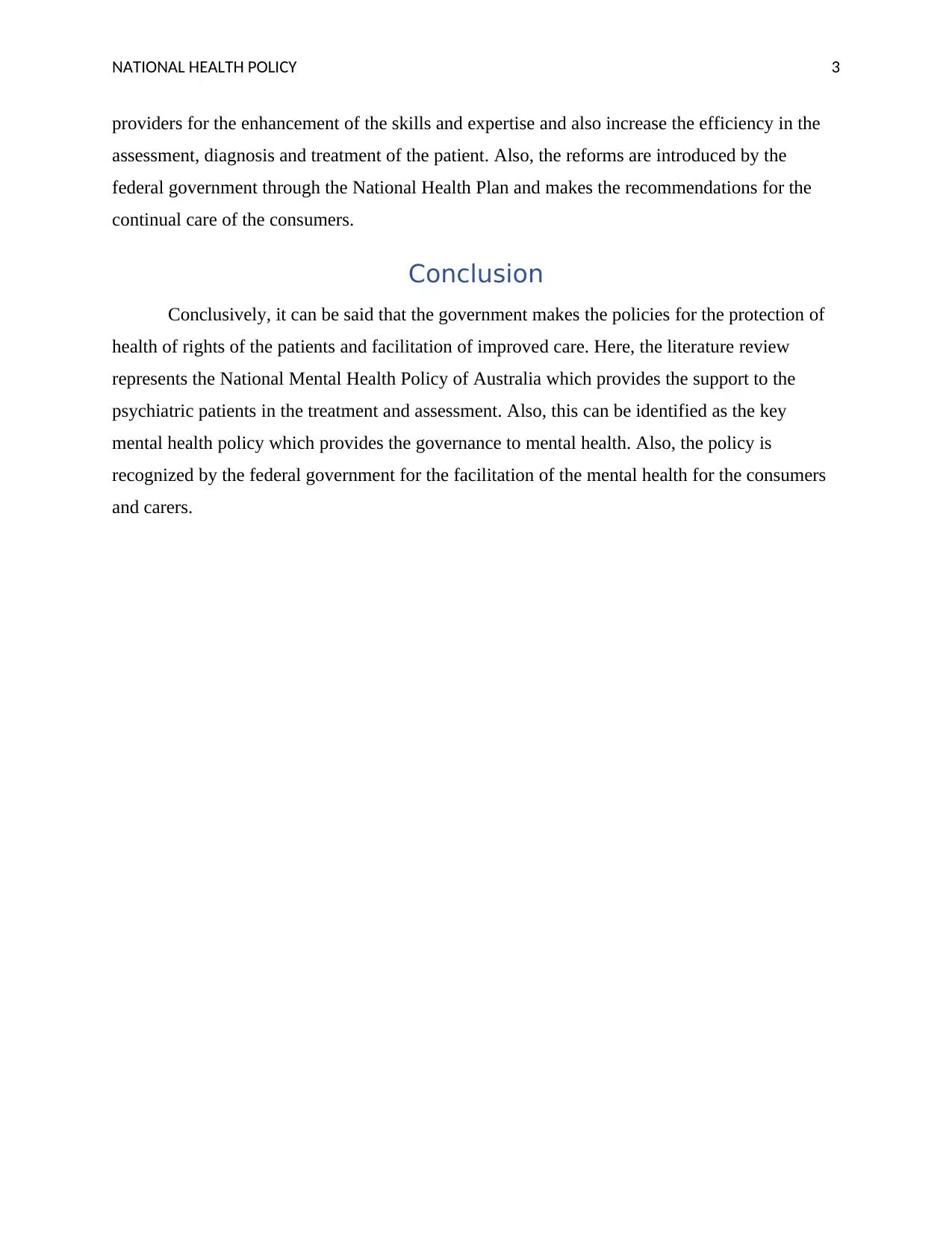
NATIONAL HEALTH POLICY 3
providers for the enhancement of the skills and expertise and also increase the efficiency in the
assessment, diagnosis and treatment of the patient. Also, the reforms are introduced by the
federal government through the National Health Plan and makes the recommendations for the
continual care of the consumers.
Conclusion
Conclusively, it can be said that the government makes the policies for the protection of
health of rights of the patients and facilitation of improved care. Here, the literature review
represents the National Mental Health Policy of Australia which provides the support to the
psychiatric patients in the treatment and assessment. Also, this can be identified as the key
mental health policy which provides the governance to mental health. Also, the policy is
recognized by the federal government for the facilitation of the mental health for the consumers
and carers.
providers for the enhancement of the skills and expertise and also increase the efficiency in the
assessment, diagnosis and treatment of the patient. Also, the reforms are introduced by the
federal government through the National Health Plan and makes the recommendations for the
continual care of the consumers.
Conclusion
Conclusively, it can be said that the government makes the policies for the protection of
health of rights of the patients and facilitation of improved care. Here, the literature review
represents the National Mental Health Policy of Australia which provides the support to the
psychiatric patients in the treatment and assessment. Also, this can be identified as the key
mental health policy which provides the governance to mental health. Also, the policy is
recognized by the federal government for the facilitation of the mental health for the consumers
and carers.
Paraphrase This Document
Need a fresh take? Get an instant paraphrase of this document with our AI Paraphraser
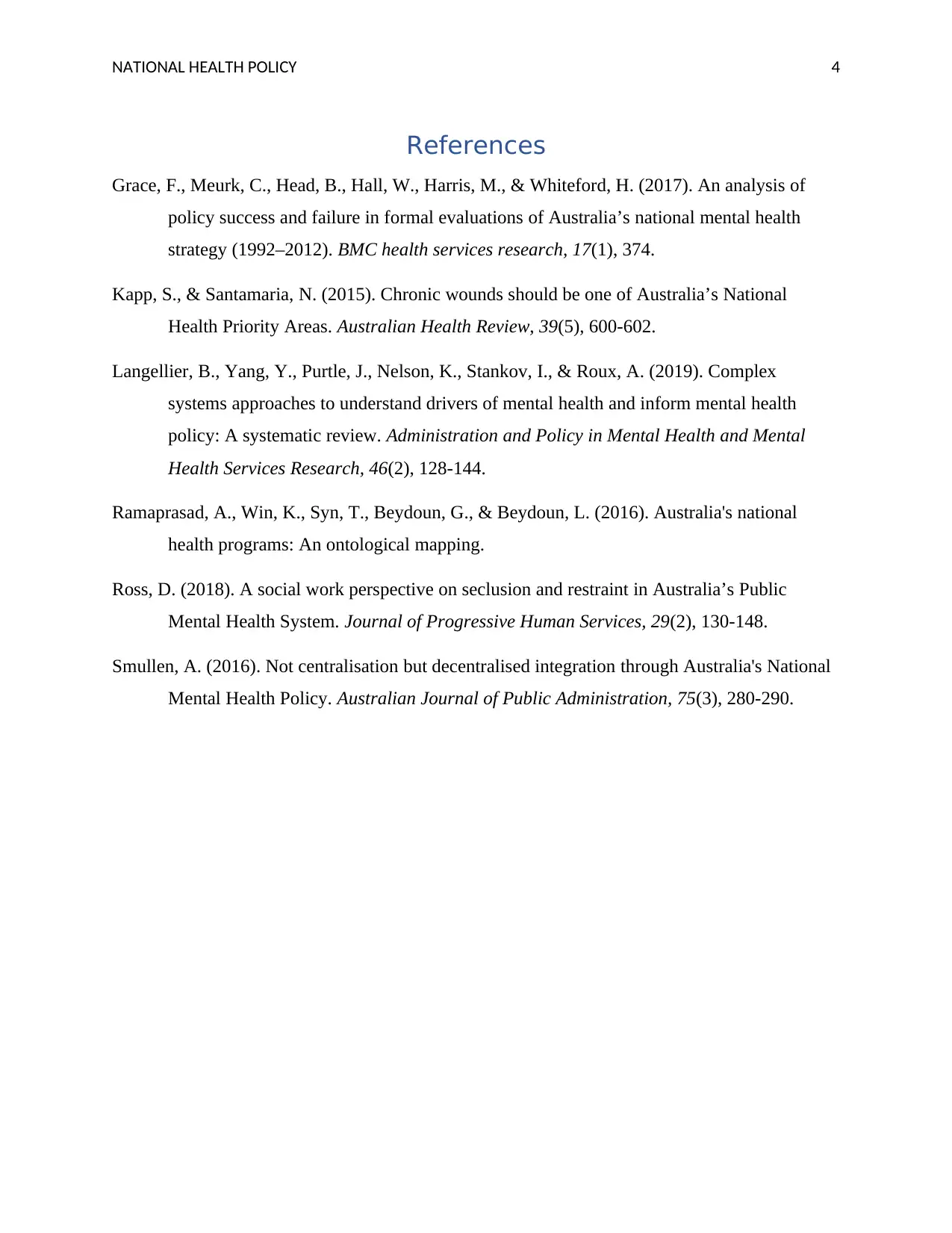
NATIONAL HEALTH POLICY 4
References
Grace, F., Meurk, C., Head, B., Hall, W., Harris, M., & Whiteford, H. (2017). An analysis of
policy success and failure in formal evaluations of Australia’s national mental health
strategy (1992–2012). BMC health services research, 17(1), 374.
Kapp, S., & Santamaria, N. (2015). Chronic wounds should be one of Australia’s National
Health Priority Areas. Australian Health Review, 39(5), 600-602.
Langellier, B., Yang, Y., Purtle, J., Nelson, K., Stankov, I., & Roux, A. (2019). Complex
systems approaches to understand drivers of mental health and inform mental health
policy: A systematic review. Administration and Policy in Mental Health and Mental
Health Services Research, 46(2), 128-144.
Ramaprasad, A., Win, K., Syn, T., Beydoun, G., & Beydoun, L. (2016). Australia's national
health programs: An ontological mapping.
Ross, D. (2018). A social work perspective on seclusion and restraint in Australia’s Public
Mental Health System. Journal of Progressive Human Services, 29(2), 130-148.
Smullen, A. (2016). Not centralisation but decentralised integration through Australia's National
Mental Health Policy. Australian Journal of Public Administration, 75(3), 280-290.
References
Grace, F., Meurk, C., Head, B., Hall, W., Harris, M., & Whiteford, H. (2017). An analysis of
policy success and failure in formal evaluations of Australia’s national mental health
strategy (1992–2012). BMC health services research, 17(1), 374.
Kapp, S., & Santamaria, N. (2015). Chronic wounds should be one of Australia’s National
Health Priority Areas. Australian Health Review, 39(5), 600-602.
Langellier, B., Yang, Y., Purtle, J., Nelson, K., Stankov, I., & Roux, A. (2019). Complex
systems approaches to understand drivers of mental health and inform mental health
policy: A systematic review. Administration and Policy in Mental Health and Mental
Health Services Research, 46(2), 128-144.
Ramaprasad, A., Win, K., Syn, T., Beydoun, G., & Beydoun, L. (2016). Australia's national
health programs: An ontological mapping.
Ross, D. (2018). A social work perspective on seclusion and restraint in Australia’s Public
Mental Health System. Journal of Progressive Human Services, 29(2), 130-148.
Smullen, A. (2016). Not centralisation but decentralised integration through Australia's National
Mental Health Policy. Australian Journal of Public Administration, 75(3), 280-290.
1 out of 5
Related Documents
Your All-in-One AI-Powered Toolkit for Academic Success.
+13062052269
info@desklib.com
Available 24*7 on WhatsApp / Email
![[object Object]](/_next/static/media/star-bottom.7253800d.svg)
Unlock your academic potential
Copyright © 2020–2025 A2Z Services. All Rights Reserved. Developed and managed by ZUCOL.





